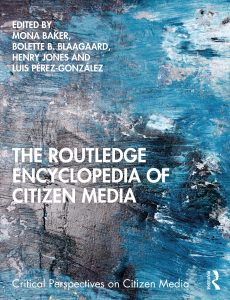
Citizen media have flourished and taken on new forms on the internet, and people with disabilities have been among the pioneers in this area as they sought to increase their agency in how disability is represented and aimed to create media that are not only accessible, but also relevant to people with a wide range of disabilities. I explored the evolution of “Disability Media” — media created by people with disabilities with a view to presenting distinctive disability viewpoints on key issues and experiences relevant to the disability community — and their relationship with ever changing technologies in an entry in the recently published Routledge Encyclopedia of Citizen Media.
There is an incredible amount of grassroots innovation in today’s disability media, and this new entry seeks to capture and critically discuss the work of these citizen media activists in conjunction with long term trends in media representations and technological evolution. Here’s a short summary of the entry (contact me for a pre-print copy of the full text):
Disability and disability-related issues are often ignored or misrepresented in mainstream news and popular media. Disability scholars have also argued that initiatives launched by major news organizations to provide better representations of disability, such as the BBC’s Ouch! website, have fallen short of expectations to incorporate the perspective of persons with disabilities effectively (Riley 2005). In addition, traditional forms of media are not fully accessible to Deaf and hard-of-hearing people, nor to people with different disabilities including, to name a few, blind and vision-impaired people, people with intellectual disabilities, and language processing issues. To address these problems, disability communities and Disabled People’s Organizations (DPOs) have built alternative media outlets with a view to providing accessible news coverage, enhancing the visibility of disability issues, and contrasting ableist and stereotypical representations of disability both within news and popular culture (Ellis and Goggin 2015a; Haller, 2010). While historically most of these efforts were oriented toward the provision of information to the disability community and meeting its various accessibility needs, the proliferation of digital media has enabled exponential growth in the disability media sector. Dozens of new disability news websites, blogs, podcasts, sign language video services on YouTube and other media are created every year, and can reach ever expanding audiences (Ellis and Goggin 2015b). Importantly, many of these outlets seek to have an impact beyond the disability community and influence legacy media and non-disabled audiences more broadly.
This entry provides a brief history of disability media initiatives and reviews their relationship with the changing technologies and organizational structures that support them. In particular, grassroots projects that seek to empower aspiring disabled writers, reporters, and videographers and augment the visibility of their content, such as Rooted in Rights and The Disability Visibility Project, are presented. The entry discusses how these initiatives, which follow in the footsteps of community-based projects that equipped people with disabilities with key journalistic skills (Thorsen, Jackson and Luce 2015) and build on the use of unmediated storytelling in disability rights advocacy (Trevisan, 2017), empower new disabled voices to challenge the status quo, enrich news and popular culture with more diverse disability representations, and can become catalysts for the participation of the disability community in key civic moments such as elections and important policy debates.

 My latest article “Using the Internet to Mobilize Marginalized Groups: People with Disabilities and Digital Campaign Strategies in the 2016 U.S. Presidential Election” was recently published in the International Journal of Communication. This article discusses how the 2016 campaigns – particularly Hillary Clinton’s – tried to engage with the disability community online and draws key lessons about the inclusion of people with disabilities and other minority groups in digital election strategy planning. The full paper can be accessed freely
My latest article “Using the Internet to Mobilize Marginalized Groups: People with Disabilities and Digital Campaign Strategies in the 2016 U.S. Presidential Election” was recently published in the International Journal of Communication. This article discusses how the 2016 campaigns – particularly Hillary Clinton’s – tried to engage with the disability community online and draws key lessons about the inclusion of people with disabilities and other minority groups in digital election strategy planning. The full paper can be accessed freely 
